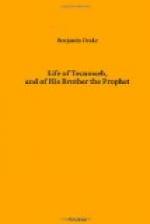which tribe an individual belongs; but to the casual
observer, there are no visible shades of difference.
In each of the four tribes, except the Mequachake,
the chiefs owe their authority to merit, but in the
last named, the office is hereditary. Of the
origin of the Piqua tribe, the following tradition
has been recited:[A] “In ancient times, the
Shawanoes had occasion to build a large fire, and after
it was burned down, a great puffing and blowing was
heard, when up rose a man from the ashes!—hence
the name Piqua, which means a man coming out of the
ashes.” Mequachake, signifies a perfect
man. To this tribe the priesthood is confided.
The members, or rather certain individuals of it,
are alone permitted to perform the sacrifices and other
religious ceremonies of the tribe.[B] The division
of the tribe into bands or totems, is not peculiar
to the Shawanoes, but is common to several other nations.
One of the leading causes of its institution, was the
prohibition of marriage between those related in a
remote degree of consanguinity. Individuals are
not at liberty to change their totems, or disregard
the restraint imposed by it on intermarriages.
It is stated in Tanner’s narrative, that the
Indians hold it to be criminal for a man to marry
a woman whose totem is the same as his own; and they
relate instances where young men, for a violation of
this rule, have been put to death by their nearest
relatives. Loskiel, in his history of the Moravian
missions, says, the Delawares and Iroquois never marry
near relatives. According to their own account,
the Indian nations were divided into tribes for the
sole purpose, that no one might, either through temptation
or mistake, marry a near relation, which is now scarcely
possible, for whoever intends to marry must take a
person of a different totem. Another reason for
the institution of these totems, may be found in their
influence on the social relations of the tribe, in
softening private revenge, and preserving peace.
Gallatin, on the information derived from a former
Indian agent[C] among the Creeks, says, “according
to the ancient custom, if an offence was committed
by one or another member of the same clan, the compensation
to be made, on account of the injury, was regulated
in an amicable way by the other members of the clan.
Murder was rarely expiated in any other way than by
the death of the murderer; the nearest male relative
of the deceased was the executioner; but this being
done, as under the authority of the clan, there was
no further retaliation. If the injury was committed
by some one of another clan, it was not the injured
party, but the clan to which he belonged, that asked
for reparation. This was rarely refused by the
clan of the offender; but in case of refusal, the injured
clan had a right to do itself justice, either by killing
the offender, in case of murder, or inflicting some
other punishment for lesser offences. This species
of private war, was, by the Creeks, called, ’to




